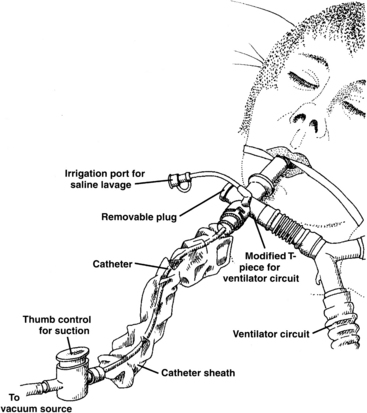PROCEDURE 12 • Endotracheal and tracheostomy tubes are used to maintain a patent airway and to facilitate mechanical ventilation. The presence of these artificial airways, especially endotracheal tubes, prevents effective coughing and secretion removal, necessitating periodic removal of pulmonary secretions with suctioning. In acute care situations, suctioning is always performed as a sterile procedure to prevent hospital-acquired pneumonia. • Suctioning is performed with one of two basic methods. In the open-suction technique, after disconnection of the endotracheal or tracheostomy tube from any ventilatory tubing or oxygen sources, a single-use suction catheter is inserted into the open end of the tube. In the closed-suction technique, also referred to as in-line suctioning, a multiple-use suction catheter inside a sterile plastic sleeve is inserted through a special diaphragm attached to the end of the endotracheal or tracheostomy tube (Fig. 12-1). The closed-suction technique allows for the maintenance of oxygenation and ventilation support, which may be beneficial in patients with moderate to severe pulmonary insufficiency. In addition, the closed-suction technique decreases the risk for aerosolization of tracheal secretions during suction-induced coughing. Use of the closed-suction technique should be considered in patients with cardiopulmonary instability during suctioning with the open technique, who have high levels of positive end-expiratory pressure (PEEP; >10 cm H2O) or inspired oxygen (greater than 80%) or both, who have grossly bloody pulmonary secretions, or in whom airborne transmission of disease, such as active pulmonary tuberculosis, is suspected. • Indications for suctioning include the following: • Suctioning of airways should be performed only for a clinical indication and not as a routine fixed-schedule treatment. • Hyperoxygenation always should be provided before and after each pass of the suction catheter into the endotracheal tube, whether with the open or closed suctioning method. • Suctioning is a necessary procedure for patients with artificial airways. When clinical indicators of the need for suctioning exist, there is no absolute contraindication to suctioning. In situations in which the development of a suctioning complication would be poorly tolerated by the patient, strong evidence of a clinical need for suctioning should exist. • Complications associated with suctioning of artificial airways include the following: • Tracheal mucosal damage (epithelial denudement, hyperemia, loss of cilia, edema) occurs during suctioning when tissue is pulled into the catheter tip holes. These areas of damage increase the risk of infection and bleeding. Use of special-tipped catheters, low levels of suction pressure, or intermittent suction pressure has not been shown to decrease tracheal mucosal damage with suctioning. • Postural drainage and percussion may improve secretion mobilization from small to large airways in diseases with large mucus production (e.g., cystic fibrosis, bronchitis). • Adequate systemic hydration and supplemental humidification of inspired gases assist in thinning secretions for easier aspiration from airways. Instillation of a bolus of normal saline solution does not thin secretions, may cause decreases in arterial and mixed venous oxygenation, and may contribute to lower airway contamination from the mechanical dislodgment of bacteria within the artificial airway or from contamination of saline solution during instillation.26 • The suction catheter should not be any larger than half of the internal diameter of the endotracheal or tracheostomy tube. Table 12-1 Guideline for Catheter Size for Endotracheal and Tracheostomy Tube Suctioning* *This guide should be used as an estimate only. Actual sizes depend on the size and individual needs of the patient. Always follow manufacturer’s guidelines. Adapted from St John RE, Seckel M: Airway management. In AACN protocols for practice: care of the mechanically ventilated patient series, Sudbury, MA, 2007, Jones & Bartlett Publishers, 41.
Suctioning: Endotracheal or Tracheostomy Tube
PREREQUISITE NURSING KNOWLEDGE
 Secretions in the artificial airway
Secretions in the artificial airway
 Suspected aspiration of gastric or upper airway secretions
Suspected aspiration of gastric or upper airway secretions
 Auscultation of adventitious lung sounds (rhonchi) over the trachea or main-stem bronchi or both
Auscultation of adventitious lung sounds (rhonchi) over the trachea or main-stem bronchi or both
 Increase in peak airway pressures when patient is on mechanical ventilation
Increase in peak airway pressures when patient is on mechanical ventilation
 Increase in respiratory rate or frequent coughing or both
Increase in respiratory rate or frequent coughing or both
 Gradual or sudden decrease in arterial blood oxygen (PaO2), arterial blood oxygen saturation (SaO2), or arterial saturation via pulse oximetry (SpO2) levels
Gradual or sudden decrease in arterial blood oxygen (PaO2), arterial blood oxygen saturation (SaO2), or arterial saturation via pulse oximetry (SpO2) levels
 Sudden onset of respiratory distress, when airway patency is questioned
Sudden onset of respiratory distress, when airway patency is questioned
 Cardiac dysrhythmias (premature contractions, tachycardias, bradycardias, heart blocks)
Cardiac dysrhythmias (premature contractions, tachycardias, bradycardias, heart blocks)
 Decreases in mixed venous oxygen saturation (SVO2)
Decreases in mixed venous oxygen saturation (SVO2)
 Increased intracranial pressure
Increased intracranial pressure
 Pulmonary hemorrhage or bleeding
Pulmonary hemorrhage or bleeding
EQUIPMENT
 Suction catheter of appropriate size (Table 12-1)
Suction catheter of appropriate size (Table 12-1)

 Sterile saline or sterile water solution
Sterile saline or sterile water solution
![]()
Stay updated, free articles. Join our Telegram channel

Full access? Get Clinical Tree


12: Suctioning: Endotracheal or Tracheostomy Tube









